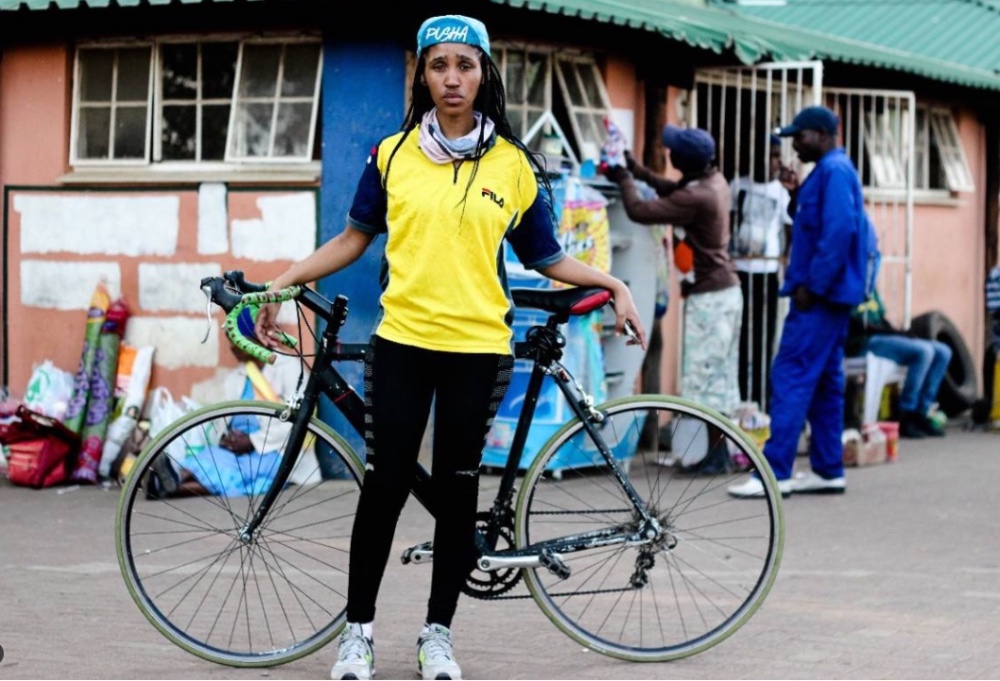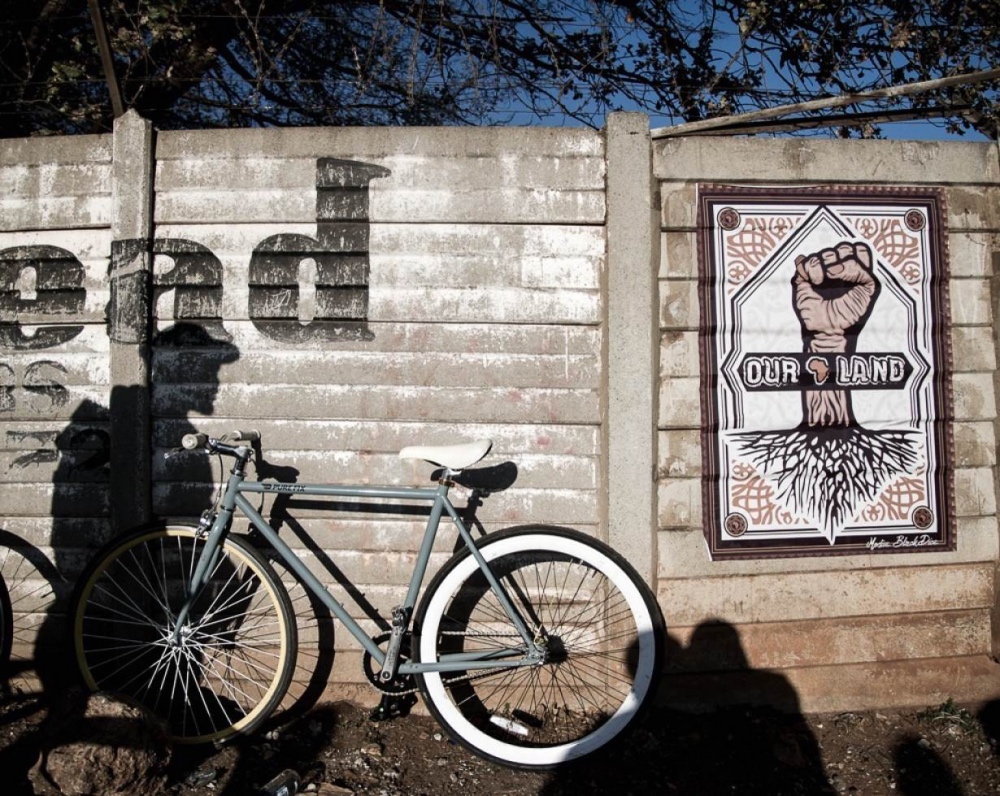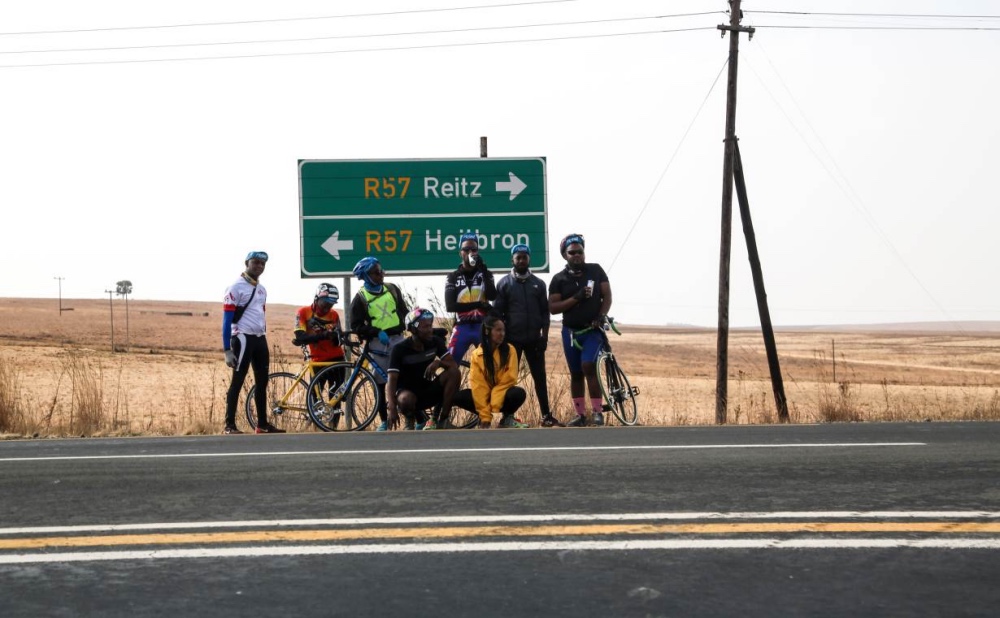
KIM HARRISBERG, writing for the Thomson Reuters Foundation, looks at how a cycling initiative is breaking down barriers…
Johannesburg, South Africa
Thomson Reuters Foundation
Lesego Konupi was just a toddler when he learned to hide under his grandmother’s table at the sound of the gunshots that came to define South Africa’s anti-apartheid struggle.
It was at that same house east of Johannesburg where Konupi was gifted his first bicycle, and where, years later, he and three friends would start a collective that uses bicycles to cross the physical and social boundaries created by apartheid.
“On our bicycles, we don’t think about the city divides. We just move,” said Konupi of Bicycle Stokvel, which takes its name from the South African word for informal savings groups.

Maria Kgatitsoe, the only female cyclust to ride to Durban in South Africa with the Stokvel group, strikes a poses in the town of Ladysmith. PICTURE: Courtsy of Lesego Button Konupi.
Towns and cities remain racially divided more than 20 years after the end of apartheid, when millions of blacks were forcibly removed from white-only urban areas to live in crowded townships and homelands, with buffer zones separating the races.
The legacy of apartheid-era city planning is one reason why, 25 years after South Africa’s first democratic elections, the country is still considered the most unequal in the world, according to the World Bank.
“On our bicycles, we don’t think about the city divides. We just move.”
– Lesego Konupi of Bicycle Stokvel
The idea behind Bicycle Stokvel, said Konupi, is to help young people living in townships overcome the limitations imposed on them by apartheid urban planners through cycling, art and music.
Every three months cycling enthusiasts gather for a group ride through Vosloorus township, stopping along the way to discuss the photography or drawings the group’s artists have displayed on the walls of taxi ranks and abandoned buildings.
The rides, which sometimes grow to about 150 people, are free to join and the group provides bikes for anyone who needs one.
“It is our opportunity to document township life the way we see it, not how others see us,” said Konupi, wearing jeans, a shirt and a hat all designed by Vosloorus artists.
“Instead of putting alcohol or politics in people’s minds, we are pushing new ideas instead.”
The group hosts ‘hangouts’ where local musicians, photographers, stylists and cinematographers come together to listen to live music and share ideas and skills.
Bicycle Stokvel often stages rides in Johannesburg, where Konupi now lives and works as a photographer.
In 2018 the group cycled to Durban, 550 kilometres from Vosloorus.
“The trip made us see that even if you don’t have a lot [of money] there are ways of exploring our country and also our continent,” said Konupi.
This year, they plan on cycling across country borders to Eswatini (formerly known as Swaziland), Mozambique and Botswana.

A cyclist’s shadow is seen across a wall displaying the artwork of local Vosloorus creatives in South Africa. This is part of the Bicycle Stokvel’s interactive cycling events designed to promote local art. PICTURE: Courtesy of Khotso Bantubahle Mahlangu.
Konupi’s mission to bring people together by bike stands out in a country where few people cycle.
According to the 2014 National Household Travel Survey, minibus taxis are the main means of transport for 68 per cent of households in Gauteng province with private cars, buses and trains making up much of the rest of the city’s transport.
“There are huge safety concerns for cyclists,” said Susan Monyai, head of marketing at the Johannesburg Development Agency.
“There are not enough safe spaces for them to lock up their bicycles and it is risky for them to cycle at night.”
Bicycle Stokvel often runs up against another relic of apartheid-era city planning: the lack of accessible cycle lanes between townships and the city centre.
“There are huge safety concerns for cyclists. There are not enough safe spaces for them to lock up their bicycles and it is risky for them to cycle at night.”
Susan Monyai, head of marketing at the Johannesburg Development Agency.
Cyclists have to share the road with cars, buses and minibus taxis in a country with a poor road safety record, despite a modern road network. More than 14,000 people were killed in road accidents in 2017, according to official statistics.
Former Johannesburg mayor Parks Tau had plans to establish more bike lanes throughout the city. But, when voters replaced him with Herman Mashaba from the main opposition party in 2016, funding was cut from the bicycle lane project.
“This was a real sad turn of events for the city,” Rehana Moosajee, a former member of the mayoral transport committee, told the Thomson Reuters Foundation.
“I understand there are competing priorities, but it is possible to establish safer infrastructure in cheaper ways.”
Luyanda Mfeka, a spokeswoman for mayor Mashaba, confirmed that the cycling lanes had been “deprioritised for now”.
Moosajee, who now runs a training business, pointed to Bicycle Stokvel as an example of how social integration can be achieved through minimal resources.
“The stokvel are weaving together community, art, culture and sport to show that we all have an equal right to access the city,” she said.

The Bicycle Stokvel team poses for a photo during their cycling trip to Durban from Vosloorus, South Africa, a 600 kilometre journey. PICTURE: Kelebogile Mokonyane
For the women in the group, that means finally being able to ride at night.
“As a female cyclist, I cannot ride alone,” said Maria Kgatitsoe, who was the only woman on the ride to Durban.
“But riding alone in a minibus taxi at night is not safe either.”
In South Africa, women are murdered at a rate five times higher than the global average, according to the World Health Organization.
“I want other women to feel they can do anything in this country,” Kgatitsoe added.
“That is how I felt when I cycled to Durban.”
Cycling is one way to reclaim the city from its apartheid past, but the government also needs to look at new forms of urban planning, said Monyai of the JDA.
She would like to see more mixed-income housing estates built close to industrial and commercial areas.
“Improving pedestrian bridges, walkways and public transport are equally important,” she added.
Moosajee said the key to making cities more integrated is empathy.
“I am referring to conversations between and within communities and government,” she said. “An inability to hear different perspectives shapes the way our cities are governed.”
For Konupi, the best conversation starter is the novelty of seeing a group of people gliding by on their bikes through Johannesburg’s inner city.
“People stand in the streets at night and cheer for us,” he said.
“Street children, sex workers, students, everyone. We feel free.”





